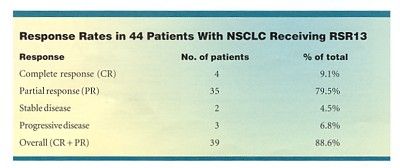Hemoglobin Modifier May Enhance RT in Lung Cancer
SAN FRANCISCO-Used with concurrent radiation therapy after induction chemotherapy, an investigational agent that decreases hemoglobin’s oxygen-binding affinity produced good response rates and favorable projected survival rates in patients with unresectable non-small-cell lung cancer (NSCLC).
SAN FRANCISCOUsed with concurrent radiation therapy after induction chemotherapy, an investigational agent that decreases hemoglobin’s oxygen-binding affinity produced good response rates and favorable projected survival rates in patients with unresectable non-small-cell lung cancer (NSCLC).
Decreased affinity for hemoglobin caused by the agent, RSR13, increases tissue oxygenation, allowing radiation to produce more free radicals, therefore killing more tumor cells, said Hak Choy, MD, Vanderbilt University Medical Center. In hypoxic tumors without free radicals, radiation-damaged DNA can be repaired, allowing tumor cells to survive, Dr. Choy said in an interview at the 37th Annual Meeting of the American Society of Clinical Oncology (ASCO).
Dr. Choy and his colleagues conducted a prospective, open-label, multicenter phase II study with endpoints of response rate, toxicity, and survival. The study included 52 patients with locally advanced, unresectable stage IIIA and IIIB NSCLC from 13 institutions.
Patients received two cycles of induction paclitaxel (Taxol) (225 mg/m2) and carboplatin (AUC 6), followed by a daily infusion of RSR13 (75 mg/kg, with possible adjustments to 100 or 50 mg/kg) over 30 minutes prior to thoracic radiation therapy (32 fractions at 2 Gy for a total of 64 Gy over 7 weeks). Dr. Choy said that 71% of patients completed more than 90% of RSR13 doses.
After 2 months of follow-up, with 44 patients evaluable, the overall response rate was 88.6% (see Table). With median follow-up of 11.5 months, estimated overall survival at 1 year was 64.7%, and projected 2-year survival was 50.8%. Median survival time has not been reached, but was estimated at 14 months.

Dr. Choy commented: "If you give paclitaxel and carboplatin followed by radiation alone, you would expect a response rate in the 55% to 65% range, with an estimated 1-year survival in the 55% to 65% range and a 2-year survival in the 30% to 35% range, or at best 40%."
Dr. Choy said that extreme caution was exercised because of potential problems with hypoxemia in such advanced lung cancer patients. Patients were given face masks and a full liter of oxygen during the infusion. He noted, however, that difficulties were less than anticipated, and that with the drug’s short (15 minute) half-life, hypoxemia occurred in only 19% of patients and was transient.
Grade 3-4 treatment-related radiation pneumonitis was seen in 13% of patients and grade 3-4 dyspnea in 9%. Most patients could go home within 15 to 30 minutes of treatment. "Importantly, this is not a cytotoxic drug, so there were no other side effects," Dr. Choy added.
More study is needed, Dr. Choy said, noting also that the regimen is somewhat difficult to deliver because of the need to monitor oxygenation.
Session discussant Mitchell Machtay, MD, Hospital of the University of Pennsylvania, mentioned that hypoxia is associated with radiation therapy resistance, angiogenesis, and poor radiation therapy outcome in many types of solid tumorsand is extremely common in NSCLC. He found the RSR13 response rates and projected survival to be favorable.
"Toxicity was acceptable, and it is important to note that there was no esophagitis," Dr. Machtay said. "The 89% response rate is quite good and is comparable to, if not better than, many concurrent chemoradiation series." He cautioned that the follow-up period was short, and it remains to be seen whether response rates will hold up on longer follow-up.
Newsletter
Stay up to date on recent advances in the multidisciplinary approach to cancer.